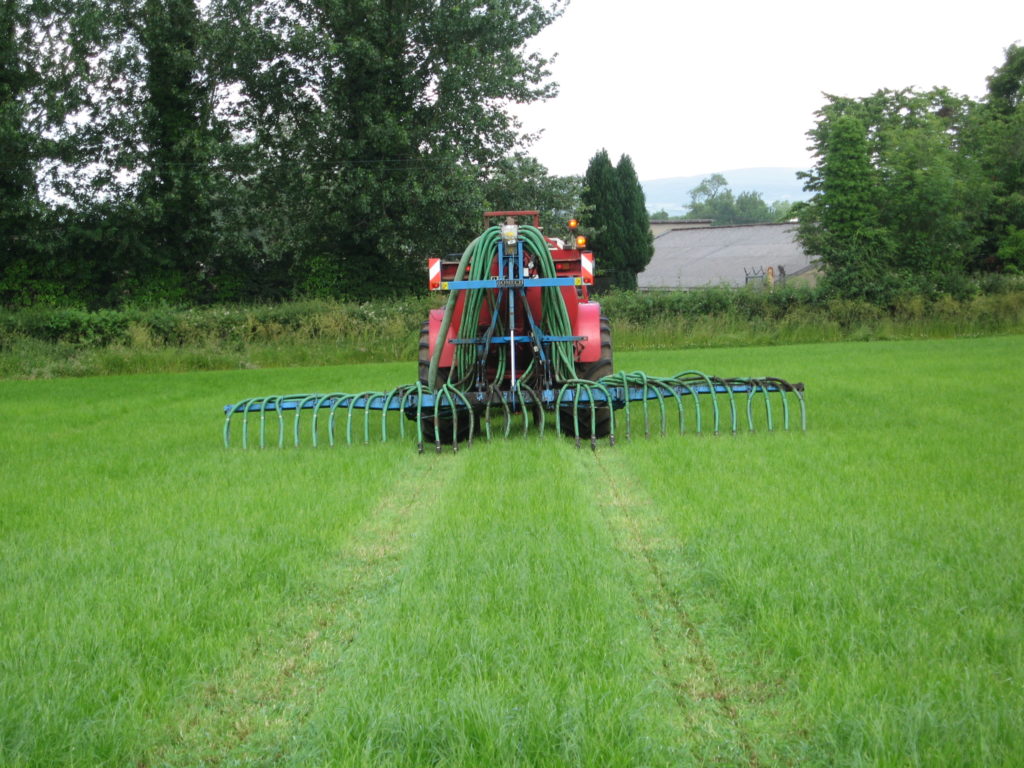Preparation for Second Cut Silage
May 19, 2020
Christopher Breen, CAFRE Dairying Development Adviser, Enniskillen
Soil sampling results are key to working out how much slurry and fertiliser to apply. If you do not have these results no phosphate can be applied. The online CAFRE Crop Nutrient Calculator found at DAERA Online Services is useful for working out slurry and fertiliser requirements for second cut silage based on soil analysis. The fertiliser rate should be 80 – 100 kg N / ha (80 units per acre) allowing for any slurry nitrogen (N) applied (approximately 6 units N in 1000 gallons of slurry in the summer). Include phosphate (P) and potash (K) depending on soil analysis. If your soil analysis has shown low indices for P and K (1 or below) a compound fertiliser such as 27:4:4 or 27:6:6 will help to make up the shortfall in P and K. If only the K index is low then a zero P compound such as 26:0:6 should be used.
At soil index 2 for phosphate and index 1 for potash, typical indices of fields with a history of being cut for silage, slurry has the potential to provide some of the nitrogen and potash and all of the phosphate. An application of 22 cubic metres of dairy cow slurry per hectare (2,000 gallons per acre) and 375 kg (three bags per acre) of a 24:0:13 type fertiliser can meet second cut requirements at these indexes. At a practical level evenly spread slurry improves silage fermentation and minimises sward damage.
All silage cuts should receive sulphur (S) each year at 30 – 40 kg/ha (24 – 32 units per acre). Research has shown that there are yield responses to additional S in most soils especially on sandy soils and where high N levels – over 100 kg N/ha (80 units/acre) are used.

Spreading Slurry with a Trailing Shoe
Use of low emission slurry spreading equipment (LESSE)
Low emission spreading equipment to spread slurry is becoming more common on farms. Such equipment is being encouraged to improve air quality as less of the nitrogen in the slurry is lost as ammonia into the atmosphere. Use of a trailing shoe or band spreader rather than the traditional inverted splash plate has many benefits for the farmer:
• Better nitrogen utilisation
• Produces better grass yields to same fertiliser input – Trailing shoe +24% more grass and by band spreader +16% more grass
• Less grass contamination
• Slurry can be spread up to 4 weeks after cutting
• Slurry can be spread within 3m of a watercourse rather than 10m
Use of LESSE has now become a legal requirement for farms operating under a nitrates derogation, with all slurry spread after 15th June on such farms needing to be applied using one of the low emission techniques.
Liming of Grassland
Often not treated as a priority, liming is critical to ensuring good grass growth. Consideration should be given now to lime applications where soil analysis shows a need. The pH for mineral soils should be 6.0 – 6.5.
Applying lime will:
• Correct the soil pH
• Allow nutrients in the soil to become more available
• Allow nutrients supplied by fertiliser to become more available
• Improve soil structure
• Encourage earthworms
• Help to reduce weeds
• Help to keep ryegrass and clover in the swards
When should liming be carried out?
In the past, on many farms lime was only applied at reseeding. However liming more often is important where soil analysis shows a need. The availability of granulated lime has made application easier throughout the grazing season. As ground lime has varying particle sizes it takes the larger particles longer to break down so traditionally ground lime was applied in the autumn to allow breakdown over the winter. Applying slurry soon after the application of lime is not recommended due to the increased risk of ammonia N volatilisation. Spreading lime one to two weeks after a slurry application doesn’t cause a problem.
Should ground limestone or granulated lime be used?
This will depend on a number factors:
- Soil pH – a very low soil pH (5.2) will require high quantities of granulated lime which will be much more expensive than ground lime.
- Flexibility of use – Granulated lime can be applied by a fertiliser spreader, without need for employing a contractor. It can also be applied on small areas more easily.
- Availability – granulated lime is finer and more quickly available as a neutralising agent. Ground lime takes time to break down but acts over a longer period.
- Cost – granulated lime is more expensive but is easy to use – see approximate amounts and costs.
Choice of liming material, amounts needed and approximate cost
| Soil pH | Ground limestone / Magnesium limestone | Granulated lime | |
| pH 5.7 | Kg required / acre | 1 000 | 400 |
| Cost / acre | £20 | £50 + application | |
| pH 5.2 | Kg required / acre | 2 000 | 800 |
| Cost / acre | £40 | £100 + application |
Summary
- Use the CAFRE Crop Nutrient Calculator to determine slurry and fertiliser requirements for 2nd cut silage.
- Use a fertiliser containing sulphur.
- Use of LESSE allows for better efficiency as less nitrogen is lost as ammonia.
- Correcting soil pH through liming is crucial to improve grass growth.
- Granulated or ground limestone should be used to improve soil pH with each product having its advantages.
Discuss liming and fertiliser recommendations with your local CAFRE Dairy Development Adviser or telephone 0300 200 7843 and ask to be directed to a local adviser.
